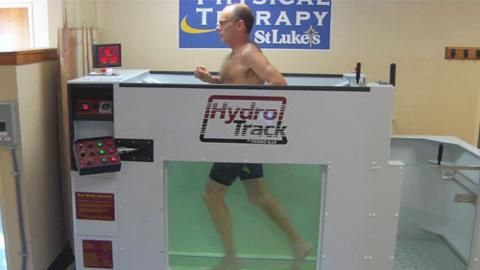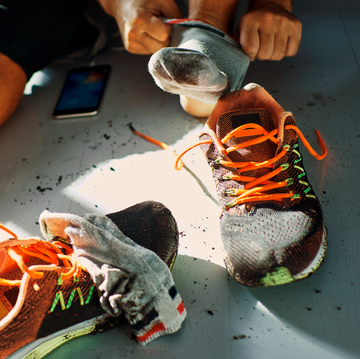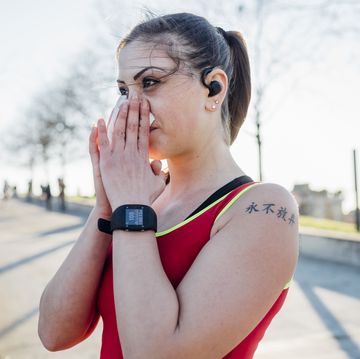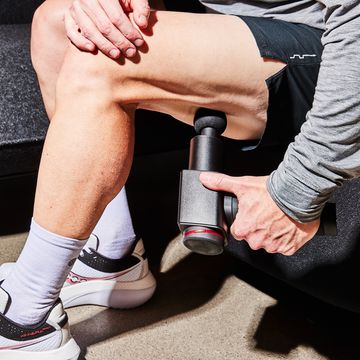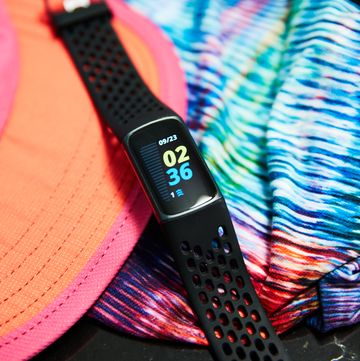Budd Coates, Runner's World coach and four-time Olympic Marathon Trials qualifier, recently tried the Hydro Track.
If you're sidelined with an injury, the quicker you can get healthy and return to running, the better, right?
Rehabbing on an underwater treadmill could be your solution. And you don't necessarily have to be an elite runner to take a dip in it.
"Water is a great medium to exercise in," said Timothy Miller, a physical therapist who is the Regional Director of Sports Rehabilitation at St. Luke's Physical Therapy in Bethlehem, Pennsylvania. "The buoyancy of the water decreases stress on the joints, the viscosity provides resistance for strength training, and the hydrostatic pressure helps support the body providing a safe workout environment."
Since underwater treadmills mimic on-land running and provide comparable cardiovascular benefits, runners can avoid losing too much fitness while rehabbing. Running through water forces your muscles to work harder than air does, so you can get in a solid workout without running as fast or as far as you normally would outside.
"People can get a good jog in between 4 mph and 5 mph," Miller said. "When I use it, I try to run the same amount of time I would for a regular run, but it ends of being around half the distance."
And you don't have to be injured to reap its benefits. An underwater treadmill is a great option if you're looking to add extra mileage without the extra wear and tear on your legs or if you want to bounce back more quickly after harder efforts. Elite coach Alberto Salazar has his althetes, like top distance runner Galen Rupp, use the aquatic 'mill to supplement their weekly mileage and recover from their road work.
Here are a few common questions and answers about the system:
What do you wear?
Spandex or fitted technical apparel work best, but regular swimwear is also a good option. Most athletes run barefoot since running shoes - even minimal models like Vibrams - tend to get soaked and heavy.
How does water alter the amount of impact on your body?
Waist-height water reduces your body weight by about 50 percent. Chest-height water creates close to a 75-percent weight reduction. This lowers the impact forces on an existing injury so you can begin therapy sooner while retaining muscle strength and conditioning.
What are examples of injuries that can be used for rehabilitation with an underwater treadmill?
According to Miller, most common running injuries can be treated with an underwater treadmill, including Achilles tendinitis, plantar fasciitis, iliotibial band syndrome (ITBS), and generic knee pain. The system can also help rehab injuries like ankle sprains, fractures, and ACL reconstruction. Although the treadmill will not cure an injury, it does provide a means to maintain fitness and rebuild muscle strength, which can speed recovery.
What kinds of treadmills are available?
There are two types of underwater treadmills. One system involves a freestanding tub that includes a motorized belt, adjustable water heights, and the ability to turn on jets for added resistance. The water in these free-standing tubs can be heated to around 90 to 95 degrees. (Traditional-pool temperature is 78 to 85 degrees). The warmth promotes flexibility, helps the muscles relax, and reduces fatigue. Hudson Aquatic Systems manufactures three systems (including the Hydro Track above). HydroWorx and Hydro Physio are other companies that offer comparable systems.
The other type of underwater treadmill involves more minimal machines that are placed into a standard pool or rehabilitation tub. Some versions are self-propelled (like the systems produced by Aquabilt), while others have adjustable speed settings for the belt. (Both Hudson Aquatic Systems and Hydro Physio also offer this type of treadmill). In most instances, the height of the water is dependent on where the machine is placed in the pool.
How does running on an underwater treadmill compare to aqua jogging?
Aqua jogging involves mimicking running form while in a pool. Floatation devices often are worn around the midsection to keep the runner from sinking. "When you're aqua jogging, your feet aren't touching the floor, and you're propelled at a very slow pace," Miller said. (Learn more about aqua jogging here.)
"In the Hydro Track [or any underwater treadmill], you're able to actually work on mechanics and running technique. It's a mix between running outside and running on a treadmill but still having the effects of the aquatics," Miller said. "But for an off-day recovery run, aqua jogging works fine because you can go through and relieve all those stresses."
What are the downsides to using an underwater treadmill?
"I think the biggest downside is availability," Miller said. "They are very common in professional sports and at the Olympic training level, but there aren’t many available to the general public. But if someone has access to one, I would highly recommend using one. Utilizing the Hydro Track or another type of underwater treadmill can help to speed up the rehabilitation from an injury as the athlete is making gains in strength, range of motion, and gait techniques while in a safe environment that they may not have been able to do if they weren’t in the water."
Where can I find an underwater treadmill?
"Physical therapy clinics and athletic training rooms offer these systems," Miller said. "They do sell treadmills that you put into an existing pool, and I know a lot of the bigger universities with big sports programs have one type or another, too." Check with your local physical therapist to see if one is available near you.
How much does it cost per session?
If you're receiving therapy for an injury, your insurance should cover most of the expenses. But if you'd like to use an underwater treadmill to supplement your road mileage, your local facility should provide you with the cost per session. For example, at the St. Luke's facility in Bethlehem, the cost for an uninjured runner using the Hydro Track for cross-training would be $35 for a 30-minute session. Costs may vary among facilities.
